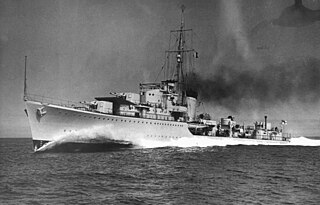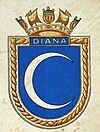
HMS Kelly was a K-class destroyer of the British Royal Navy, and flotilla leader of her class. She served through the early years of the Second World War; in Home Waters, off Norway and in the Mediterranean. Throughout her service, Kelly was commanded by Lord Louis Mountbatten, as commander of the 5th Destroyer Flotilla. She was lost in action in 1941 during the Battle of Crete.

HMS Imogen was a I-class destroyer built for the Royal Navy in the mid-1930s. During the Spanish Civil War of 1936–1939, the ship enforced the arms blockade imposed by Britain and France on both sides as part of the Mediterranean Fleet. After the start of the Second World War the ship was transferred to Home Fleet and participated in the Norwegian Campaign in April 1940. Imogen sank two German submarines before her own sinking following an accidental collision in July 1940.

HMS Hostile (H55) was an H-class destroyer built for the Royal Navy in the 1930s. She was the first and so far only Royal Navy ship to bear the name Hostile. During the Spanish Civil War of 1936–1939 the ship spent considerable time in Spanish waters, enforcing the arms blockade imposed by Britain and France on both sides of the conflict. She was transferred to Freetown, Sierra Leone, in October 1939 to hunt for German commerce raiders in the South Atlantic with Force K. Hostile participated in the First Battle of Narvik in April 1940 and the Battle of Calabria in July 1940. The ship was damaged by a mine off Cape Bon in the Strait of Sicily while on passage from Malta to Gibraltar on 23 August 1940. She was then scuttled by HMS Hero.

HMS Glowworm was a G-class destroyer built for the Royal Navy in the mid-1930s. During the Spanish Civil War the ship spent part of 1936 and 1937 in Spanish waters, enforcing the arms blockade imposed by Britain and France on both sides of the conflict. Glowworm was transferred from the Mediterranean Fleet shortly after the beginning of World War II to the British Isles, to escort shipping in local waters. In March 1940, she was transferred to the Home Fleet, just in time to participate in the opening stages of the Norwegian Campaign. On 8 April 1940 Glowworm encountered German destroyers transporting troops to invade Norway in Operation Weserübung. The German destroyers attempted to disengage while calling for help from the heavy cruiser Admiral Hipper. Glowworm was heavily damaged by Admiral Hipper, but still attempted to torpedo the German ship. In chaos of the battle, the heavily damaged Glowworm ended up ramming Admiral Hipper, which broke the bow off Glowworm, and she sank shortly afterwards.

HMS Griffin (H31) was a G-class destroyer, built for the Royal Navy in the mid-1930s. In World War II she took part in the Norwegian Campaign of April–May 1940 and the Battle of Dakar in September before being transferred to the Mediterranean Fleet in November. She generally escorted larger ships of the Mediterranean Fleet as they protected convoys against attacks from the Italian Fleet. Griffin took part in the Battle of Cape Matapan in March 1941 and the evacuations of Greece and Crete in April–May 1941. In June she took part in the Syria-Lebanon Campaign and was escorting convoys and the larger ships of the Mediterranean Fleet until she was transferred to the Eastern Fleet in March 1942.

The C and D class was a group of 14 destroyers built for the Royal Navy in the early 1930s. As in previous years, it was originally intended to order a complete flotilla comprising eight destroyers—plus a flotilla leader as the ninth unit—in each year. However, only four ships—plus a leader—were ordered under the 1929–30 Programme as the C class. The other four ships planned for the C class were never ordered as an economy measure and disarmament gesture by the Labour government of Ramsay MacDonald. A complete flotilla—the 'D' class—was ordered under the 1930–31 Programme.

HMS Afridi was one of 16 Tribal-class destroyers built for the Royal Navy shortly before the beginning of Second World War in 1939. Completed in 1938 the ship was initially assigned to the Mediterranean Fleet where she served as a flotilla leader. Afridi was briefly involved enforcing the arms blockade on the combatants in the Spanish Civil War. The ship returned home shortly after the start of the Second World War and was assigned convoy escort duties. She played an active role in the Norwegian Campaign of April–May 1940, escorting convoys to and from Norway. Afridi was sunk by German dive bombers on 3 May as she was escorting the evacuation convoy after the failure of the Namsos Campaign.

HMS Grafton (H89) was a G-class destroyer built for the Royal Navy during the mid-1930s. During the Spanish Civil War of 1936–1939 the ship spent considerable time in Spanish waters, enforcing the non-intervention measures agreed by Britain and France. After the beginning of World War II she was transferred from the Mediterranean Fleet to Great Britain for escort and contraband inspection duties. Grafton was refitting when the Norwegian Campaign began in April 1940, but the ship escorted convoys to Norway once her refit was completed. She evacuated British troops from the Dunkirk bridgehead in May, but was sunk by a German submarine after she stopped to rescue survivors from another British destroyer.

HMS Ardent was one of eight A-class destroyers built for the Royal Navy (RN) in the 1920s. The ship spent most of the 1930s assigned to the Mediterranean Fleet. During the early months of the Spanish Civil War of 1936–1939, Ardent spent considerable time in Spanish waters enforcing the arms blockade imposed by Britain and France on both sides of the conflict.

HMS Acasta was one of eight A-class destroyers built for the Royal Navy (RN) in the 1920s. The ship spent most of the 1930s assigned to the Mediterranean Fleet. During the early months of the Spanish Civil War of 1936–1939, Acasta spent considerable time in Spanish waters enforcing the arms blockade imposed by Britain and France on both sides of the conflict.

HMS Brazen was a B-class destroyer built for the Royal Navy around 1930. Initially assigned to the Mediterranean Fleet, she was transferred to Home Fleet in 1936. The ship escorted convoys and conducted anti-submarine patrols early in World War II before participating in the Norwegian Campaign in April–May 1940. Brazen later began escorting coastal convoys in the English Channel and was sunk in late July 1940 by German aircraft whilst doing so.

HMS Escapade was an E-class destroyer built for the Royal Navy in the early 1930s. Although assigned to the Home Fleet upon completion in 1934, the ship was attached to the Mediterranean Fleet in 1935–1936 during the Abyssinia Crisis. During the Spanish Civil War of 1936–1939 she spent considerable time in Spanish waters, enforcing the arms blockade imposed by Britain and France on both sides of the conflict. Escapade was assigned to convoy escort and anti-submarine patrol duties in the Western Approaches when World War II began in September 1939, but transferred back to the Home Fleet at the end of the year.

HMS Forester was one of nine F-class destroyers built for the Royal Navy during the early 1930s. Although assigned to the Home Fleet upon completion, the ship was attached to the Mediterranean Fleet in 1935–36 during the Abyssinia Crisis. A few weeks after the start of World War II in September 1939, she helped to sink one German submarine and then participated in the Second Battle of Narvik during the Norwegian Campaign of 1940. Forester was sent to Gibraltar in mid-1940 and formed part of Force H where she participated in the attack on the Vichy French ships at Mers-el-Kébir and the Battle of Dakar between escorting the aircraft carriers of Force H as they flew off aircraft for Malta and covering convoys resupplying and reinforcing the island until late 1941. During this time the ship helped to sink another German submarine.

HMS Fortune was one of nine F-class destroyers built for the Royal Navy in the mid-1930s. Although she was assigned to the Home Fleet upon completion, the ship was detached to the Mediterranean Fleet to enforce the arms blockade imposed by Britain and France on both sides during the Spanish Civil War of 1936–39. Several weeks after the start of the Second World War in September 1939, Fortune helped to sink a German submarine. The ship escorted the larger ships of the fleet during the early stages of World War II and played a minor role in the Norwegian Campaign of 1940. Fortune was sent to Gibraltar in mid-1940 and formed part of Force H where she participated in the Battle of Dakar against the Vichy French. The ship escorted numerous convoys to Malta in 1940–41 until she was badly damaged by Italian bombers in mid-1941.

HMS Foxhound was one of nine F-class destroyers built for the Royal Navy in the mid-1930s. Although she was assigned to the Home Fleet, the ship was detached as part of the Mediterranean Fleet to enforce the arms blockade imposed by Britain and France on both sides during the Spanish Civil War of 1936–39. Several weeks after the start of the Second World War in September 1939, Foxhound helped to sink a German submarine and participated in the Second Battle of Narvik during the Norwegian Campaign of April–June 1940. The ship was sent to Gibraltar in mid-1940 and formed part of Force H where she participated in the attack on Mers-el-Kébir. Foxhound escorted the aircraft carriers of Force H as they flew off aircraft for Malta and covered convoys resupplying and reinforcing the island until late 1941. During this time the ship helped to sink another German submarine.

HMS Delight was a D-class destroyer built for the Royal Navy in the early 1930s. Delight was initially assigned to the Mediterranean Fleet before she was transferred to the China Station in early 1935. She was temporarily deployed in the Red Sea during late 1935 during the Abyssinia Crisis, before returning to her duty station where she remained until mid-1939. Delight was transferred back to the Mediterranean Fleet just before the Second World War began in September 1939. She served with the Home Fleet during the Norwegian Campaign. The ship was sunk by German dive-bombers on 29 July 1940 while attempting to transit the English Channel in daylight.

HMS Acheron was an A-class destroyer of the Royal Navy. She served during the Second World War in Home waters and off the Norwegian coast, before becoming an early war loss when she sank after hitting a mine off the Isle of Wight on 17 December 1940. The wrecksite is designated under the Protection of Military Remains Act 1986.

HMS Codrington was one of nine A-class destroyers built for the Royal Navy during the 1920s. She was the flotilla leader for the class. During the Second World War she served in Home waters and off the Norwegian coast, before being bombed and sunk on 27 July 1940 whilst in dock at Dover.

HMS Anthony was an A-class destroyer of the Royal Navy. She served in the Second World War.

The second HMS Wivern, was a Modified W-class destroyer of the British Royal Navy that saw service in World War II.




















